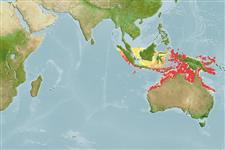Environment: milieu / climate zone / depth range / distribution range
Ecologia
marinhas associadas(os) a recifes; intervalo de profundidade 40 - 80 m (Ref. 75154). Tropical; 4°N - 24°S, 91°E - 154°E (Ref. 55)
Eastern Indian Ocean: known only from a few specimens collected at Indonesia (off Sumatra and Sulawesi) and west of Kuri Bay, Western Australia.
Tamanho / Peso / Idade
Maturity: Lm ? range ? - ? cm
Max length : 30.0 cm TL macho/indeterminado; (Ref. 55)
Espinhos dorsais (total): 10; Raios dorsais moles (total): 13-14; Espinhos anais 3; Raios anais moles: 8 - 9. Snout somewhat pointed, dorsal profile of head sloping steeply. Preorbital bone relatively narrow, its width usually slightly less than eye diameter. Preopercular notch and knob poorly developed. Scale rows on back rising obliquely above lateral line. Generally red or pink when fresh; fins are red or orange. Juveniles under 10 cm SL have blackish caudal fin lobe tips, frequently also a crescentic blackish blotch in the middle of the caudal fin, sometimes also with a yellowish mid-lateral stripe extending from the rear edge of the operculum to the middle of the caudal fin.
Adults inhabit deeper reef areas. They occur solitarily or in small groups.
Life cycle and mating behavior
Maturidade | Reprodução | Desova | Ovos | Fecundidade | Larvas
Allen, G.R., 1985. FAO Species Catalogue. Vol. 6. Snappers of the world. An annotated and illustrated catalogue of lutjanid species known to date. FAO Fish. Synop. 125(6):208 p. Rome: FAO. (Ref. 55)
Categoria na Lista Vermelha da IUCN (Ref. 130435)
Ameaça para o homem
Harmless
Utilização humana
Pescarias: espécies comerciais
Mais informação
Nomes comunsSinónimosMetabolismoPredadoresEcotoxicologiaReproduçãoMaturidadeDesovaAgregação para desovaFecundidadeOvosDesenvolvimento dos ovos
ReferênciasAquaculturaPerfil para aquaculturaEstirpesGenéticaElectrophoresesHereditariedadeDoençasProcessamentoNutrientsMass conversion
ColaboradoresFotografiasStamps, Coins Misc.SonsCiguateraVelocidadeTipo de nataçãoÁrea branquialOutras referênciasCérebrosVisão
Ferramentas
Relatórios especiais
Descarregue XML
Fontes da internet
Estimates based on models
Preferred temperature (Ref.
123201): 25.9 - 27.9, mean 27.3 °C (based on 75 cells).
Phylogenetic diversity index (Ref.
82804): PD
50 = 0.5000 [Uniqueness, from 0.5 = low to 2.0 = high].
Bayesian length-weight: a=0.01479 (0.00706 - 0.03101), b=2.97 (2.81 - 3.13), in cm total length, based on LWR estimates for this Genus-body shape (Ref.
93245).
Nível Trófico (Ref.
69278): 3.8 ±0.6 se; based on size and trophs of closest relatives
Resiliência (Ref.
120179): Médio, tempo mínimo de duplicação da população 1,4 - 4,4 anos (Preliminary K or Fecundity.).
Fishing Vulnerability (Ref.
59153): Low vulnerability (20 of 100).
Nutrients (Ref.
124155): Calcium = 46.2 [30.7, 63.9] mg/100g; Iron = 0.374 [0.241, 0.560] mg/100g; Protein = 18.5 [17.0, 19.8] %; Omega3 = 0.151 [0.107, 0.208] g/100g; Selenium = 57.7 [39.0, 82.9] μg/100g; VitaminA = 170 [33, 621] μg/100g; Zinc = 0.486 [0.389, 0.671] mg/100g (wet weight);
